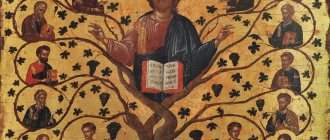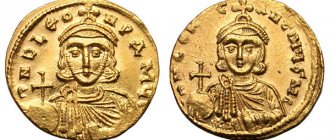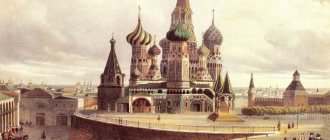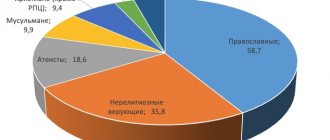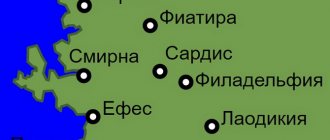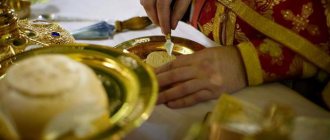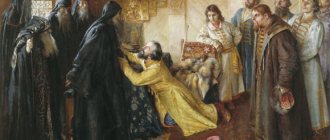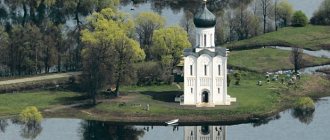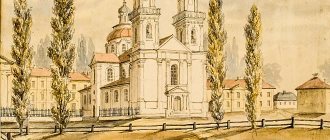Monophysite churches on the website of Igor Garshin.
Ancient Eastern churches Home
| Write |
Home > Esoterics > Religions > Christianity > Ancient Eastern churches
Alphabetical list of pages: | | | | | E (Yo) | | | | | | | | | | | | | | | | | | | | | | | | 0-9 | AZ (English)
Ancient Eastern Churches - a group of ancient churches of Eastern Christianity that recognize the decrees and profess the doctrinal dogmas of only the first 2 or 3 Ecumenical Councils
.
These include the Dyophysite Assyrian
and 6 Monophysite churches (
Armenian
,
Coptic
,
Malankara
,
Syrian
,
Eritrean
,
Ethiopian
).
The last 6 Eastern churches are called "Oriental Orthodox" or "Ancient Orthodox" churches. They do not recognize Chalcedon and all subsequent Ecumenical Councils
, in connection with which they are also called
Miaphysite
and
non-Chalcedonian
churches.
The Dyophysite Assyrian Church of the East recognizes even less - only the first two Ecumenical Councils.
Sections of the page about ancient Eastern churches:
- Dyophysite, Monophysite and Miaphysite Christologies
- Assyrian Church of the East
- Armenian Apostolic Church
- Coptic Orthodox Church
- Malankara Orthodox Church
- Syro-Jacobite Orthodox Church
- Malankara Orthodox Church (St. Thomas Christians)
- Eritrean Orthodox Church
- Ethiopian Orthodox Church
Dyophysite, Monophysite and Miaphysite Christologies
Diaphysitism
The Assyrian Church of the East does not belong to the Miaphysite non-Cholcedonian Churches, which are the Armenian, Coptic and other churches. The Assyrians profess the Nestorian interpretation of Christianity. They recognize only the first 2 Ecumenical Councils, the Miaphysites - 3, and the Orthodox and Catholics - all 7. The Nestorians do not recognize the Virgin Mary as the Mother of God. For them, she is an ordinary woman who gave birth to a boy, who later became God.
Miaphysitism
Miaphysitism (from ancient Greek μία - “single” + φύσις - “nature, nature”) is a Christological doctrine of the ancient Eastern churches, affirming the unity of the Theanthropic nature of Jesus Christ. Arose in the 5th century as a result of the theological polemics of St. Cyril of Alexandria from the Alexandrian theological school against Nestorius of Constantinople
, according to Antiochian theology, who preached natural division in Christ.
The term “miaphysitism” by those professing this doctrine is derived from that attributed to Athanasius the Great
formulas “μία φύσις τοῦ θεοῦ λόγου σεσαρκωμένη.”
Using this formula, St.
Cyril refuted
the diophysitism of Nestorius
(two natures, two hypostases, one person), arguing that in order to confess the One Person of the incarnate Son of God, the two perfect natures of God and man must be in unity (ancient Greek “μία φύσις”) and form a single hypostasis .
Unlike the Monophysite
Eutyches
heresy ,
miaphysitism
does not teach about the mixing of two natures in Christ or the absorption of one into the other, but speaks only about their indissoluble unity with the complete preservation of their properties, which is emphasized in one of his works by the famous miaphysite theologian Pope of Alexandria (Coptic Orthodox Church) Shenouda III.
(Wikipedia)
Assyrian (Syro-Persian) Church of the East [Dyophysite = Nestorian]
| The Syro-Persian Church belongs to Nestorian Church . Formed in 484 on the basis of the Persian (“Chaldean”) Church and the Patriarchate of “Seleucia-Ctesiphon” (modern Baghdad). It spread throughout Arabia, Northern India and Central Asia (up to and including China) among the Turkic and Mongolian peoples. In the VII-XI centuries. - the largest Christian Church in terms of territory. In the XIV century. almost completely destroyed by Tamerlane. In 1898, several thousand Isors (Assyrian Christians) from Turkey, led by Arch. Mar Jonah of Urmia transferred to the Russian Orthodox Church [and the rest?]. Assyrian Church of the East (or simply Church of the East ) is the only ancient Eastern Church currently existing that rejects not only |
Literature[ | ]
- Branitsky A. G., Kornilov A. A.
Religions of the region. - N. Novgorod: Nizhny Novgorod State University named after N. I. Lobachevsky, 2013. - 305 p. - Bishop Porfiry (Uspensky), “Christian East” (Kyiv, 1873);
- Voznesensky, “Monophysites in Abyssinia” (in “Spirit. Conversation” 1863);
- Zephaniah (Sokolsky), bishop.
Modern life and liturgy of Christians of heterodox Jacobites and Nestorians. — St. Petersburg: Type. spirits magazine “The Wanderer”, 1876. - 507 p. - Archpriest Petrov, “Eastern Christian Societies” (with atlas, St. Petersburg, 1876).
- Peoples and religions of the world. Encyclopedia. - M., 2000
- Seleznev N.N.
Interpretations of the origin of the name “Jacobites” among medieval Arabic-speaking Egyptian authors // Bulletin of the Russian State University for the Humanities: Series “Oriental Studies, African Studies” 20 (100). 2012. - pp. 153-168.
Armenian Apostolic Church
The Armenian Church worships Jesus Christ, the Son of God, incarnate from two natures, Divine and human, and the Savior of the world”...His Body, one with God, could not see corruption.
Armenian Apostolic Church
is part of the Ancient Eastern Churches.
According to legend, it goes back to the apostles Thaddeus
and
Bartholomew
.
Historically formed in the 320s, through the works of St. Gregory the Illuminator (d. 335), whose son and successor, Aristakes, was a participant in the First Ecumenical Council. In its dogmatics it is based on the decisions of the first three Ecumenical Councils and adheres to the Christology of St. Cyril of Alexandria
(so-called miaphysitism [
monophysitism
?]).
Has seven sacraments, honors the Mother of God, icons, etc. in the IV Ecumenical Council
for objective reasons and did not recognize its resolutions (distorted by translation). In the period from 491 to 536 it finally separated from the unity of the Universal Church. Currently it has dioceses within Armenia and several others in America, Asia, Europe and Australia.
Christianity appeared in Armenia very early, and although the information left by Abgar is very unclear, nevertheless, the first reliable news comes from the 2nd century [!]. Christianity, heavily persecuted, sometimes completely disappeared there, until finally Bishop Gregory the Illuminator
Tiridates
in 301 and in the 5th century
Mesrop
did not translate the Bible into Armenian.
From that time on, activity began in the Armenian church, and Armenians began to frequently attend schools in Athens and Constantinople. In church disputes about the two natures of Christ, the Armenians sided with the Monophysites
with the approval of the Persian king Chosroes, who conquered the country in 536, they rejected
the formula
of the Council of Chalcedon
the Synod of Turin and since then separated into a special church, which they called honor of Gregory -
Gregorian
.
The head of their church became the Catholicos
(i.e., the universal bishop), living in
Etchmiadzin
, a monastery near Erivan, the ancient capital of Armenia.
Soon a rich scientific activity began among the Armenians, and significant theological literature preserved in Syriac began to be translated into Armenian in order to make it accessible to the Armenian clergy. Nerses-Klayetsi
, a 12th-century Armenian Catholicos whose works were published many times, is considered by Armenians their greatest theologian.
With the Greek (Orthodox) Church the Gregorians
still haven't merged. But the popes tried many times, for example, in 1145, 1341, 1440, when the Armenians turned to Western states for help against the Mohammedans, to tear the Armenians away from the old faith. The popes, however, only succeeded in creating a schism in the Armenian church.
Information on Armenian literature can be found on the Armenian language page.
- Armenian Apostolic Church. Review by P.I. Puchkova.
- Armenian Church. Brockhaus and Efron. Encyclopedic Dictionary. St. Petersburg, 1880.
- Armenian Apostolic Church - New Nakhichevan and Russian Diocese.
- Armenian Apostolic Church. On the website of the Union of Armenians of Russia.
- Reflections on the historical development of the Christological doctrine of the Armenian Church. Dvorkin A.L. [sensibly and with examples!]
Coptic Orthodox Church
The Coptic Church was founded by Saint Mark the Evangelist
, who arrived in Africa in 47-48. and preached in Alexandria, then the capital of Egypt. In 69 he was martyred by the Romans. Saint Mark is revered by the Copts as their first patriarch. From the very beginning, the Coptic Patriarch of Alexandria bore the title of pope, which was then given to the Roman bishop. The Coptic pope-patriarch is elected for life, enjoys unquestioned authority and is the leader of the nation. The current Pope, Shenouda III, was elected in 1971 and is a wonderful theologian and approachable person.
Christianity spread without much difficulty in ancient Egypt, because its inhabitants believed in the dying and resurrecting god Osiris for thousands of years. In addition, Egypt's close proximity to the Holy Land also contributed to this. It is believed that on the banks of the Nile for almost 4 years, the Virgin Mary and her husband Joseph hid little Jesus from the persecution of King Herod. These places are visited by Christian pilgrims from all over the world.
The Coptic Church belongs to the Eastern, Orthodox branch of Christianity, but there are many differences between Russian Orthodoxy and Egyptian Christianity - both in theology and in traditions. Copts are Monophysites, that is, according to their faith, Christ had a single, divine essence, and not two - divine and human. In 451, the Ecumenical Council of Chalcedon condemned Monophysitism as an erroneous doctrine, and the Coptic Church of Egypt broke away from the orthodox [Orthodox] Christian church.
The Copts were St. Athanasius, St. Basil - the author of the festive Orthodox church liturgy, St. Pakhom - the founder of the monastic and hermit movement.
Note that it was among the Copts that monasticism arose in the 3rd-4th century, which from here spread throughout the Christian world. It has become an integral part of Russian Orthodoxy. The first monastery, which still exists today, was founded in the desert in eastern Egypt by St. Anthony the Great. Almost at the same time, the monastery of St. Pavel. Saints Mary of Egypt, Venerable Macarius of Egypt, St. Catherine [the most enlightened woman of a long time, who was torn to pieces by a crowd of pagans] were born and lived on the banks of the Nile.
Despite the Arab conquest of Egypt in 641 and the persecution of Christians, Copts were highly revered in Egypt. No one demanded that they renounce Christianity; the Coptic language was even used in official documents. Now Copts make up about 9% of the Egyptian population, but there are no representatives of them in the government structures, because the official state religion is Islam. Copts are the largest Christian community in the Middle East. Monuments of Coptic antiquity are carefully restored and protected by the state; the Cairo Copt Museum houses treasures of Coptic culture.
Coptic temples are distinguished by the modesty and simplicity of their decoration, frescoes are rare, and the iconography is simplified, similar to children's drawings. Most temples have benches. But in general, from the inside they are similar to all Orthodox churches: an altar oriented to the east, a solea, an iconostasis, paintings, candles. The language of worship is ancient Coptic (its alphabet was created on the basis of Greek).
The crosses of Coptic churches have a peculiar shape: they are oriented in two directions, so when viewed from any direction the Cross is visible. Priests wear crosses, often made of leather, and wear turban caps. When entering the temple for communion, Copts must take off their shoes. They pray seven times a day, facing east, always wearing hats, and fast for most of the year. They greatly reverence the Mother of God and the saints and make sure to confess.
Copts strictly maintain the purity of their blood and take only Coptian or European women as wives. They marry only once, getting married in a church; civil marriages and divorces are not recognized among them. They keep Christian traditions very reverently, despite the fact that the majority of the country's population has long professed Islam.
Alexandria is an ancient Coptic church center; there are burial places of all the primates of the Coptic Church, starting with the Apostle Mark. But at present, the center of the Coptic Church and, in general, of the entire Coptic people is located in Cairo and includes the gigantic Cathedral of St. Mark, the ancient temple of the apostles Peter and Paul, many different services and buildings. Here is the main theological seminary of the Coptic Church, from which most of the priests graduated. The Coptic Church has 12 monasteries and 6 monasteries, where the monks live in strictness and prayer, eating mainly bread and water.
Taken from the blog "Guardian of Ideas".
Source
The origins of the Antiochian Christian community, as narrated in the New Testament biblical book of the Acts of the Apostles (c. 11, v. 19-25), go back to the first century, to the apostolic era. Several believers, who fled Palestine due to the persecution unleashed after the stoning of Saint Stephen, scattered throughout the Syrian-Phoenician region and arrived in Antioch, the capital of the Roman province of Syria, where they began to preach to the Jews living there, and later to the pagans. We are also told that it was in this city that believers in Jesus were first called Christians.
. Soon after this, the apostles Barnabas and Paul joined the Antiochian community; the city was the starting point and return point of the latter's famous missionary trips. The consideration of Simon Peter as the founder of the Church and its first bishop is due to the tradition according to which this apostle, after leaving the Jerusalem community and before arriving in Rome, lived for some time in Antioch and finally structured the local community. This tradition will be supported by the testimony of Paul himself in his Epistle to the Galatians (c. 2, v. 11), where he says that, indeed, Peter did not move to live in that community until the year 50. The fact is that Antioch was the first strong Christian Church founded outside Palestine, and that it remained as one of the largest centers of Christianity in the first centuries. [ 5 ]
Ephraim the Syrian, also known as Ephraim of Nisibian or Nisibian, was a Syrian deacon and writer, saint, Church father and Doctor of the Church, born in Nusaybin (today in Turkey) - then in the Roman province of Mesopotamia - in 306. and died in Edessa in 373. Already in his time he was known as the “Mystic”, nicknamed the “Harp of the Spirit”. [ 6 ]Only a few fragments have survived from his theological work: he wrote commentaries on all the books of Holy Scripture and numerous liturgical hymns. A poet and theologian, he was par excellence a teacher of the Syrian Church, which is why he was called "the prophet of the Syrians" and "the harp of the Holy Spirit." Saint Jerome relates that his writings were read at Eucharistic assemblies after the Holy Scriptures. [6]
Malankara Orthodox Church (St. Thomas Christians)
The Malankara Orthodox Syrian Church ("Christians of Thomas the Apostle") is an autocephalous ancient Eastern community in India, founded in 52 AD. the Apostle Thomas. Its primate bears the title of Catholicos of the East - Metropolitan of Malankara, and has a residence in Kottayam (Kerala state).
The Syro-Malankara rite (ritus Suro-Malankarensis) is one of the eastern liturgical rites. Belongs to the Syro-Antiochian, or West Syrian, ritual group, along with the Syro-Antiochian rite itself. Currently, the Malankara rite in various forms is used by Christians in the state of Kerala (India) and a minor diaspora belonging to the two Ancient Eastern Churches, the Syro-Malankara Catholic Church and several Protestant Churches.
In 1653, most of the believers separated from the Uniate Malankara Church and took the “Oath of the Kunan Cross” about disobedience to the Pope. At the same time, they consecrated Bishop Mar Thoma (he was “consecrated” by twelve priests), who headed the church. In 1761 Mar Thoma VI was ordained metropolitan by representatives of the Syrian (Orthodox) Church. In 1816, British missionaries began their activities, including translating the Bible into Malayalam.
Persecution
The Mongol invasions, beginning in the 13th century, and especially the attack of Tamerlane in 1399, destroyed the temples and monasteries of the Syriac Orthodox Christians and scattered their communities. From there the number of believers dwindled. A big blow was persecution by the Ottoman Empire during and immediately after the First World War. The Patriarchate had to move in 1924 from the monastery of Der ez-Zafaran, where it had been located since 1293, to the city of Homs in Syria. Since 1959, it opened its headquarters in Damascus. [2]
Patriarch of the Syrian Church.
Syro-Jacobite Orthodox Church
The Syro-Jacobite Orthodox Church is part of the Ancient Eastern Churches and Monophysite churches. Formed in the 540s. Syrian Monophysite bishop James Baradei
. Having endured a fierce struggle with the empire, the Jacobites in 610 surrendered themselves to the rule of the advancing Persians. In 630, under Emperor Heraclius, they partially accepted monothelitism (“one-will”) - the recognition of two essences of Christ, but a single divine will.
At the beginning of the 8th century, fleeing from the Arabs, they fled to Egypt and North-West Africa. They also settled eastward throughout Mesopotamia as far as India, where in 1665 they entered into a union with the Malabar Christians.
The total number of adherents of the Syro-Jacobite Church at the end of the 20th century was about 900 thousand people, mainly in India and Syria.
- .
external reference
- Syriac Orthodox Church of Antioch
- Syriac Orthodox Resources
| Control of authorities |
|
- Data: Q210540
- Multimedia: Syriac Orthodox Church
